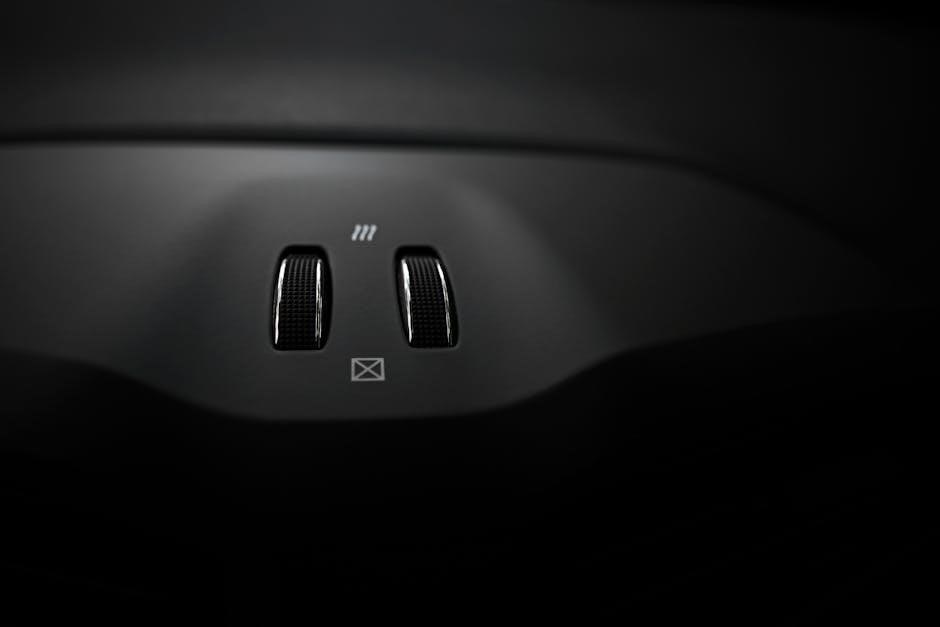These instructions guide you through setting up and operating your Honeywell light switch timer. Understanding the different models, wiring configurations (single-pole or 3-way), and programming options is crucial. This guide covers setting the time, date, and utilizing various modes like manual, automatic, and random.
Overview of Honeywell Light Switch Timers
Honeywell light switch timers offer a convenient and energy-efficient way to control your home’s lighting. These programmable timers allow you to automate your lights, providing enhanced security and helping you save on electricity bills. With features like multiple operating modes and flexible programming options, Honeywell timers are designed to fit various lifestyles and needs.
These timers are easy to install, replacing your existing light switch with a programmable control unit. They are compatible with different types of lighting, including incandescent, halogen and fluorescent, and can be used in both single-pole and 3-way wiring configurations.
The timers feature an LCD screen that displays the current time, day and load status, as well as manual override buttons that allow you to turn the lights on or off without interrupting the programmed schedule. By automating your lights, you can create the illusion that someone is home, deterring potential intruders.
Honeywell light switch timers provide a simple and effective way to manage your lighting and create a more comfortable and secure home environment. With their easy-to-use interface and advanced features, these timers are a great addition to any modern home.
Available Honeywell Timer Models (RPLS541A, RPLS530A, RPLS730B, RPLS740B, RPLS540A)
Honeywell offers a range of light switch timer models, each with its own unique features and capabilities; The RPLS541A, also known as the ECONOSwitch, is a programmable timer that helps conserve energy with manual, automatic, and random modes. The RPLS530A is a 7-day programmable timer that offers flexibility with multiple programs per week and works with various lighting types.
The RPLS730B model provides 7-day programming and is compatible with different lighting and motor loads. The RPLS740B, also an ECONOSwitch, features 7-day solar programming, which automatically adjusts the on/off times based on sunrise and sunset. Finally, the RPLS540A shares many features with the RPLS541A and works in single-switch or 3-way installations.

These timers are designed to be user-friendly, with clear LCD screens and intuitive programming interfaces. Depending on the model, they offer features like manual override, rechargeable batteries, and compatibility with different types of lights and motors.
Choose the Honeywell timer that best suits your needs and enjoy the convenience and energy savings they provide.
Single Pole (2-Wire) and 3-Way (Multi-Switch) Wiring
Honeywell light switch timers are designed to work with both single-pole (2-wire) and 3-way (multi-switch) wiring configurations, providing flexibility for various lighting setups. A single-pole switch controls a light from one location, using two wires: one connects to the power source (line), and the other connects to the light fixture (load).
A 3-way switch, on the other hand, allows you to control a light from two different locations. This setup requires three wires: a common wire, which connects to either the line or the load, and two traveler wires that run between the two switches. When installing a Honeywell timer in a 3-way configuration, it’s crucial to identify the common wire and connect it to the appropriate terminal on the timer.
Proper wiring is essential for safe and effective operation. Always consult the timer’s user manual and follow local electrical codes to ensure correct installation. If you’re not comfortable working with electrical wiring, it’s best to hire a qualified electrician.
Installation Guide: Replacing an Existing Switch

Replacing an existing light switch with a Honeywell timer involves several steps to ensure safety and proper functionality. First and foremost, always turn off the power to the circuit at the breaker box before starting any electrical work. This prevents the risk of electric shock.
Next, carefully remove the existing switch plate and unscrew the switch from the electrical box. Before disconnecting any wires, it’s a good idea to take a picture or label them to remember their original positions. This will help you connect the wires correctly to the new timer.
Once the wires are labeled, disconnect them from the old switch. Now, you’re ready to connect the wires to the Honeywell timer according to the wiring diagram provided in the user manual. Ensure all connections are secure.
After wiring, carefully tuck the wires back into the electrical box and mount the timer. Reattach the switch plate and restore power at the breaker. Test the timer.
Wiring Instructions: Line, Load, and Ground Connections
Proper wiring is crucial for the safe and effective operation of your Honeywell light switch timer. Understanding the “Line,” “Load,” and “Ground” connections is essential. The “Line” wire, typically black, brings power from the circuit breaker to the timer. The “Load” wire, also usually black, carries power from the timer to the light fixture. The “Ground” wire, usually green or bare copper, provides a path for stray electrical current, protecting against shocks.
Before wiring, ensure the power is off at the breaker. Connect the “Line” wire to the terminal labeled “Line” on the timer. Connect the “Load” wire to the terminal labeled “Load.” Securely connect the “Ground” wire to the ground screw inside the electrical box, ensuring it makes good contact.
For multi-switch (3-way) configurations, additional wiring may be required. Refer to the timer’s manual for specific instructions on connecting the traveler wires. Always double-check all connections to ensure they are tight and secure. Incorrect wiring can damage the timer or create a safety hazard.
Setting the Time and Date
Setting the correct time and date is a fundamental step to ensure your Honeywell light switch timer operates as programmed. Accurate timekeeping is essential for automatic mode, especially for features like sunset/sunrise activation.
To set the time and date, typically you’ll need to press and hold the main button or a designated “Setup” button for a few seconds. This action will access the timer’s menu. Use the up and down arrow buttons to navigate through the menu options until you find the “Time” and “Date” settings.
Once you’ve selected the “Time” setting, use the arrow buttons to adjust the hour and minute. Then, select AM or PM. Repeat this process for the “Date” setting, adjusting the month, day, and year. After setting the time and date, confirm the settings by pressing the main button again or selecting an “OK” option within the menu. Some models may automatically save the settings. It is important to consult your specific model’s manual for precise instructions.
Operating Modes: Manual, Automatic, and Random
Honeywell light switch timers offer versatility through three primary operating modes: Manual, Automatic, and Random. Each mode caters to different user needs and preferences for controlling lights.
Manual Mode: This mode operates the timer as a standard light switch. A simple press of the main button toggles the lights on or off. The timer disregards any programmed schedules and acts solely on user input. This mode is ideal when you want direct, immediate control over your lights.
Automatic Mode: In this mode, the timer follows pre-set schedules to switch lights on and off at specified times. You must program these schedules beforehand, defining the days and times for activation and deactivation. Automatic mode is perfect for regular routines and energy savings.
Random Mode: Designed to simulate occupancy, this mode introduces variability into the timer’s operation. The lights switch on and off at random intervals within a defined range. This unpredictability deters potential intruders, making it suitable for when you are away from home. The first On program usually occurs at sunset.
Manual Mode Operation
In Manual mode, your Honeywell light switch timer functions as a conventional light switch, offering straightforward, on-demand control over your lighting. This mode bypasses all programmed schedules, giving you immediate command regardless of any pre-set automatic operations. When the timer is set to Manual mode, it essentially ignores any programmed on/off times, and relies solely on your direct input to control the lights.
To operate the lights in Manual mode, simply press the main button located on the timer. A brief press will toggle the lights between the on and off states. If the lights are currently off, pressing the button will turn them on, and vice versa. This simple action provides instant control, replicating the behavior of a standard light switch.
The timer’s display usually indicates when it is in Manual mode, often with a specific icon. When the icon appears, it confirms that the timer is operating independently of any automatic programs. This clear visual cue ensures that you are aware of the current operating mode and can easily switch to Automatic or Random mode as needed.
Automatic Mode Operation and Programming
Automatic mode on your Honeywell light switch timer enables pre-programmed control of your lights, allowing them to turn on and off at specific times you set. This feature provides convenience and energy savings by automating your lighting schedule according to your needs. To utilize Automatic mode, you must first program the desired on/off times into the timer’s memory.
The programming process typically involves navigating through the timer’s menu using the buttons on the device. You’ll be able to set multiple on and off times for each day of the week, giving you a customized lighting schedule. Some Honeywell models even offer solar programming, which automatically adjusts the on/off times based on sunrise and sunset.
Once the programs are set, switching the timer to Automatic mode will activate the schedule. The lights will then turn on and off automatically according to the programmed times. The timer’s display usually indicates when it is in Automatic mode, and you can easily switch back to Manual mode if you need to override the schedule temporarily. Automatic mode is ideal for creating a consistent lighting routine and deterring intruders while you’re away.
Random Mode Operation
Random mode on your Honeywell light switch timer is designed to simulate occupancy, enhancing your home’s security while you are away. Unlike Automatic mode, which follows a pre-set schedule, Random mode introduces unpredictable on/off times, making it appear as though someone is home.
When activated, the timer will turn your lights on and off at varying intervals, mimicking typical household usage. The on-times typically last between one hour and one hour and 30 minutes, while off-times range from 15 to 30 minutes. The first “on” event usually coincides with sunset, and the last “off” event occurs between 10:30 pm and midnight. These timings are automatically adjusted daily by the timer, ensuring no predictable pattern emerges.
To engage Random mode, select it from the timer’s menu. An icon will usually appear on the display to indicate that the mode is active. While in Random mode, you can still manually override the current state of the lights by pressing the main button. This temporary override will last until the next scheduled random event or until you press the button again. Random mode is a simple yet effective way to deter potential intruders and protect your home.
Troubleshooting Common Issues
Encountering issues with your Honeywell light switch timer? Here are some common problems and their solutions. If the timer isn’t responding, first ensure the circuit breaker is on. Check the wiring connections: line, load, and ground must be securely connected. A loose wire can cause malfunction.
If the display is blank, replace the battery if applicable or check the power supply. If the timer displays incorrect time or date, recalibrate it through the settings menu. If the lights don’t switch on or off as programmed, verify the programmed times and days are correctly set.
For lights flickering, ensure the wattage of the connected lights falls within the timer’s specified range (usually between 40W and 500W). If using LED or CFL bulbs, ensure they are compatible with timers. If the timer resets frequently, check for voltage fluctuations or electrical interference. Consider relocating the timer away from other electronic devices. If problems persist, consult a qualified electrician. Remember to disconnect power before troubleshooting to prevent electrical shock. Refer to the user manual for detailed troubleshooting steps specific to your model.

Safety Precautions and Warnings
Before installing or troubleshooting your Honeywell light switch timer, prioritize safety. Always disconnect power at the circuit breaker to prevent electrical shock. Verify the timer is compatible with your electrical system, including voltage and wattage requirements. If unsure, consult a qualified electrician.
Do not exceed the maximum load capacity of the timer (typically 500W). Using higher wattage can cause overheating or fire. Ensure proper grounding to prevent electrical hazards. When wiring, carefully follow the instructions and securely connect all wires. Never touch bare wires while the power is on.
Inspect the timer regularly for signs of damage, such as cracks or loose connections. Replace damaged timers immediately. Keep the timer dry and away from moisture to prevent short circuits. Do not attempt to repair the timer yourself; seek professional assistance. Ensure the timer is installed in accordance with local electrical codes. If you are uncomfortable working with electricity, hire a licensed electrician for installation. These precautions are essential for safe operation and preventing accidents.

